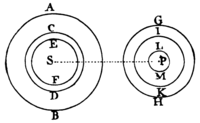Proposition LXXVI. Theorem XXXVI.
If ſpheres be however diſſimilar (as to denſity of matter and attractive force) in the progreſs right onward from the centre to the circumference; but every where ſimilar, at every given diſŧance from the centre, on all ſides round about; and the attractive force of every point decreaſes in the duplicate ratio of the diſtance of the body attracted; I ſay that the whole force with which one of theſe ſpheres attracts the other, will be reciprocally proportional to the force of the diſtance of the centres.

Imagine ſeveral concentric ſimilar ſpheres, AB, CD, EF, &c. (Pl. 22. Fig. 1.) the innermoſt of which added to the outermoſt may compoſe a matter more denſe towards the centre, or ſubducted from them may leave the ſame more lax and rare. Then by prop. 75. theſe ſpheres will attract other ſimilar concentric ſphereſ GH, IK, LM, &c, each the other, with forces reciprocally proportional to the ſquare of the diſtance SP. And by compoſition or diviſion, the ſum of all thoſe forces, or the exceſs of any of them above the others; that is, the entire force with which the whole ſphere AB (compoſed of an concentric ſpheres or of their
